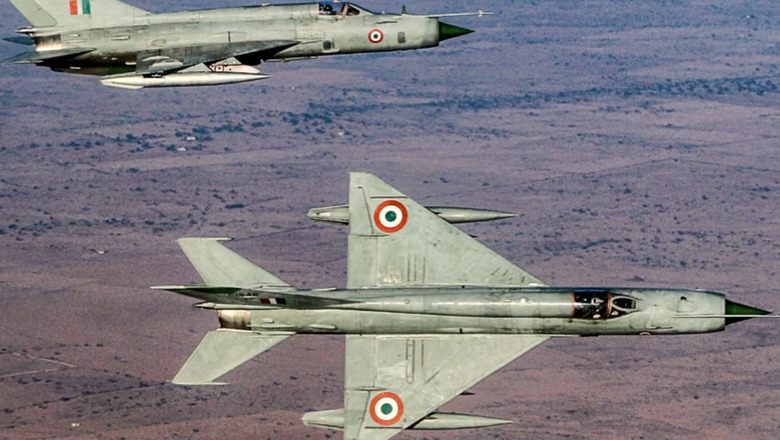
views
It was a chance conversation with someone who had a ringside view of all the air action in Kargil from the Strike Planning Cell at Srinagar that led me to the exploits of 108 Squadron equipped with the MiG-21 Type 96, also called the Hawkeyes. The squadron, where this author cut his teeth in the IAF in the early 1980s, was among the first fighter squadrons from Western Air Command to be inducted into the battle from Week One of the conflict.
Operating from the Awantipur air base in South Kashmir along with MiG-23s and MiG-27s, the squadron flew over 150 operational missions by day and night in the strike role, targeting enemy positions around Tiger Hill, Tololing and in the Batalik Sector.
What made this quest even more intriguing was when I learnt that the commanding officer of the squadron was medically down and not cleared for combat operations. This meant that Squadron Leader Vishwas Gaur (later Air Vice Marshal) and Squadron Leader A.J.S. Heer, the two experienced flight commanders along with another squadron leader, had to carry the squadron on their shoulders with a bunch of flight lieutenants and flying officers who were raring to go into action, but were inexperienced.
What is creditable though is that the commanding officer delegated complete operational responsibility to his two flight commanders, both of whom rose to the occasion brilliantly and led from the front, flying almost one third of the missions and shepherding the large number of young pilots into a ‘never attempted before’ high-altitude bombing campaign.
Enthusiasm and Innovation
Speaking to the author with candour and clarity, Heer highlighted two distinct themes that stood the squadron in good stead through the Kargil conflict. The first was the importance of ‘combat enthusiasm’ and keenness to go into battle that is always contagious should the unit leadership demonstrate it.
The second aspect where the 108 Squadron did well was to innovate and take risks even before offensive air power was committed to the operations on May 26.
Recalling a signal from Western Air Command directing all the strike squadrons to evolve suitable ultra-high altitude firing parameters for the weapons they were expected to fire (rockets and guns) soon after flying into Awantipur, Heer remembers that they were asked to identify remote mountain tops at heights that were similar to those that were suspected to be occupied in Kargil, and carry out live firing trials.
While the other squadrons found this to be highly irregular and baulked at complying (maybe correctly) because of the absence of any safety net, Gaur and Heer had other ideas because as they argued, ‘if we are going into operations blind, we might as well fire our weapons correctly.’ So, off the two went in their MiG-21s, identified a couple of remote heights northwest of the Srinagar Valley, did a few low-level runs over the crest tops to ascertain the absence of any inhabitation and then carried out trial firings one by one with the other watching from above. Having validated several firing parameters, they brought along two youngsters as wingmen and introduced them to the complexities of weapon delivery from 25,000-30,000 feet.
When the final clearance to use offensive air power came on May 26, 108 Squadron was the first squadron over Tiger Hill with a time over target (ToT) of sunrise for six aircraft. Taking off from Awantipur and routing via Ganderbal, Sonmarg and Zojila Pass, they pulled up to 30,000 feet at Matayen and targeted Tiger Hill even though they had little idea about the pinpoint location of the bunkers and gun positions around Tiger Hill.
ALSO READ | They Too Fought in Kargil: How 18 GARHWAL RIFLES Assaulted PT 5140 and PT 4700
A serving group captain (then a flying officer) described a mission to me that gave me goose pimples. “It was a conventional dive attack with rockets and guns against Pt 5140 (a part of the Tololing Complex). I was No. 2 to Gaur with a time over target block of 1106-1110. I picked up three fibre huts/tents in the dive and fired salvo rockets. As I pulled out and turned left, I confirmed that two huts were hit and I saw enemy troops running and sliding away from those huts. We were cautioned in our briefing to resist the temptation of another attack and regroup after the first pass, and if a second pass was unavoidable due to any reason, we were briefed to choose a different dive direction to give a sense of unpredictability. The adrenaline rush was too much and I wanted to hit the third tent too and that is what I did with a gun attack. The hut was engulfed in black smoke probably due to stored kerosene/fuel. Gaur probably knew what I was up to when I did not reply to his initial radio call and merely smiled at me after I landed as if to say, ‘I knew what you were up to’.”
The Impact on Enemy
Even after the IAF lost three aircraft in quick succession during the first week of the air campaign, Gaur and Heer ensured that they maintained the morale of the squadron by simply remaining positive, sticking to the task at hand and leading from the front. Most squadrons of the IAF involved in the campaign evolved their own tactics to combine mission effectiveness and safety after these losses.
Before dive attacks were stopped on May28, Gaur and Heer decided that in a two-aircraft formation, they would attack the target one by one with the other watching from above for a possible missile launch or fire and then attack from a different direction to remain unpredictable. Subsequently, however, all IAF squadrons resorted to GPS-assisted level bombing from heights that would keep them safe from the Stinger and Anza missiles.
The last innovative measure from the squadron, and one that was recognised later by the IAF, was identifying targets through crude video filming by Heer with a Panasonic hand-held camera that led to the realisation that the sophisticated Litening pod carried by the Mirage-2000s could be used to detect targets that could have escaped the human eye. The first Litening mission film which was examined by Heer led to the identification and creation of important target mosaics therafter.
The detailed analysis of the methodologies adopted by the Hawkeyes showed that the lack of consistent accuracy in the bombing effort and rocket attacks by the MiG-21s and MiG-27s had nothing to do with pilot or platform capability, but it boiled down to the absence of targeting intelligence.
Also, what was never factored in the post-conflict analysis was the huge psychological impact of the continuous non-precision bombing by squadrons like 108 Squadron on the staying capacity of the intruders, and their ultimate capitulation and withdrawal in the face of determined infantry assaults.
The exploits of a few IAF squadrons such as 7 Squadron and 17 Squadron have been well-chronicled in several narratives on the air war by this author and other accomplished air power historians such as Benjamin Lambeth. However, other squadrons which flew tirelessly through the Kargil conflict and evolved innovative tactics and weapon delivery techniques remain unheard and unsung—108 Squadron or the Hawkeyes is one among them.
On a different plane, this story highlights the quality of middle-tier leadership that held the seams of the IAF together in Kargil, much like what was seen in the Indian Army.
This is the second of a two-part series on unsung battalions and squadrons that fought in Kargil. You can read Part 1 here.
Air Vice Marshal Arjun Subramaniam (Retd) is a military historian and the author of ‘India’s Wars’ and ‘Full Spectrum’. The views expressed in this article are those of the author and do not represent the stand of this publication.
Read all the Latest News, Breaking News and Coronavirus News here.
















Comments
0 comment